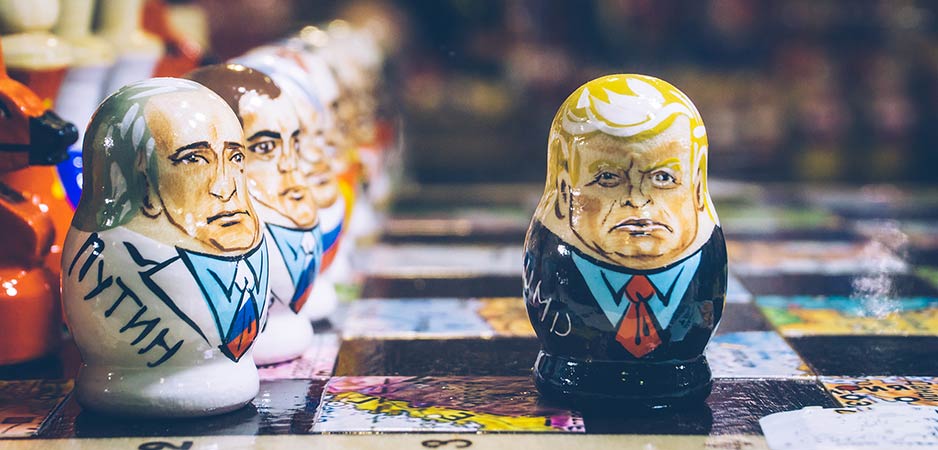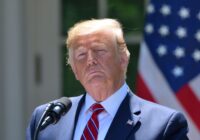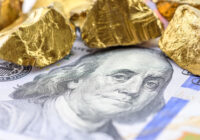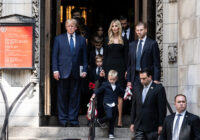In Moscow, Russian President Vladimir Putin is proposing a new constitution. Meanwhile, in Washington, US President Donald Trump is disposing of the old constitution. The first is a demonstration of power meant to showcase the unity of the Russian political system behind a strong leader. The second is an act of desperation that reveals the deep division of the American political system and the ultimate weakness of the president.
Putin will remain president until 2024 and, with this latest move, is possibly preparing the ground for an extension. Trump wants to be reelected for another term that would keep him in the Oval Office until 2024, but he has “joked” six times about becoming president for life. The fates of the United States and Russia are inextricably linked to the authoritarian narcissism of these two figures.
But these men are also part of a much longer historical development. Since the end of the Cold War, the United States and Russia have experienced an unexpected reversal in fortune.
Putin Is Leaving, But Not Saying Goodbye
Imagine sitting down in front of your computer in 1999 to try to predict the future of the United States and Russia. The trajectories seemed clear enough. The Soviet Union was dead already for eight years, the Berlin Wall was a decade gone, and the United States was the undisputed winner of the Cold War. If the 20th century was the American century, surely the 21st would be so as well.
Looking Ahead to the New Millennium
Certainly, the largest Soviet successor state, Russia, no longer seemed to be in the running. Its GDP was only a little more than half of what it had been in 1989. Inflation was raging at 36%. Billions of dollars had been siphoned out of the country during its putative “transition” to capitalism. Although life expectancy in 1988 was nearly 70 years, it dropped to below 65 years by 1994 — an unprecedented decline for a modern industrialized country not experiencing a major war.
Russia’s nascent democracy, too, was in peril. President Boris Yeltsin — frequently drunk, consistently incompetent and battling several impeachment threats — resigned on the last day of the millennium and handed power to his prime minister, Vladimir Putin. This little-known apparatchik, an alumnus of the Soviet security system, didn’t face much of a challenge.
A generation of pro-democracy advocates had been compromised by their support for the economic changes that had so clearly impoverished the vast majority of Russians. The country was edging in the direction of a failed state. With secessionist turmoil again roiling Chechnya, the very integrity of the Russian Federation hung in the balance.
Contrast conditions in Russia in 1999 with those in the United States. At that time, America was the world’s sole superpower enjoying its extended unipolar moment. The US economy was, in the 1990s, in the longest extended economic boom in its history to that point. This expansion, plus a tax increase for the wealthy and a very modest set of cuts in military spending, allowed the administration of Bill Clinton to eliminate the budget deficit by 1998. In 1999, the unemployment rate dropped to 4.1%, the lowest in 30 years.
It wasn’t exactly a progressive economic agenda, not with Clinton’s punitive welfare reform and corporate-friendly NAFTA. But it was an economic paradise compared to Russia.
The Clinton administration was also edging in the direction of greater multilateralism. It signed the Rome Statutes of the International Criminal Court, though it didn’t submit the treaty to the Senate for approval; the George W. Bush administration withdrew the US signature in 2002. Similarly, Clinton signed the Law of the Seas agreement, which the Senate refused to ratify. He also pushed for the United States to pay its unpaid dues to the United Nations. It was a compromised multilateralism — what Clinton called “à la carte” — but it was a step up from the unilateralism of the Reagan era.
On the political front, Clinton too faced impeachment and a trial. Since the Senate couldn’t muster a two-thirds majority for either count — lying under oath, obstruction of justice — Clinton remained in office. The “vast right-wing conspiracy” — the Koch brothers, the neocons, the progenitors of the alt-right — howled from the margins, but without much effect.
In 1999, at least, American democracy seemed to be in reasonably good shape, at least in comparison to what happened later: the scandalous Supreme Court judgment in the 2000 election, the transformations wrought by the Bush administration after 9/11 and the Citizens United decision on money in politics, to mention just three.
So, if you were sitting at your computer in 1999, you probably weren’t thinking much about Russia, its prospects of returning to superpower status, or any ruinous clash between Moscow and Washington. If you were worried about anything, it was Y2K followed by, maybe, China, which was finishing a decade of dramatic economic growth. Russia was becoming more insular, more illiberal, more nationalist. The United States was flexing its power, economically and militarily, but also moving toward greater diplomatic engagement with the world.
History, it seemed, had made its decision. The United States had benefited enormously from the end of the Cold War. Russia had not. Case closed.
Twenty Years Later
By 2019, the United States had traded places with Russia in many respects. Consider, for instance, US leadership. Donald Trump isn’t a drunk like Yeltsin, but you might think he was, considering the incoherence of his unscripted remarks. The American president is manifestly incompetent, which even the Pentagon acknowledges, as the new book by Carol Leonnig and Philip Rucker details. And now he is facing impeachment as well.
Were he to resign, as Yeltsin did, Trump would be replaced by someone very much like Vladimir Putin. Mike Pence is a quiet, ruthless, illiberal company man who would continue the Trumpian agenda more competently and thus more effectively. (First prize in the impeachment sweepstakes: Trump stays in office. Second prize: Trump resigns and Pence takes over. Booby prize: Trump is impeached and Pence uses his incumbent status to win the 2020 election).
Trump’s political rise has coincided with a deepening of divisions in the United States. To achieve power and push his agenda, the president has exploited those divisions on practically every issue.
Trump is not a Russian puppet. He’s not even an errand boy, as Yeltsin was for the United States. Trump likes Putin because he is drawn to strong, illiberal leaders who carefully construct their public images. Though he isn’t taking his orders from the Kremlin, Trump is nevertheless doing precisely what Putin would want from an American leader: paralyze America politically, remove any role for human rights in US foreign policy, sow discord in NATO, and get out of Russia’s way along its borders and in the Middle East.
At the level of economic indicators, the American economy couldn’t be more different from Russia circa 1999. Unemployment and inflation are both low; Wall Street is booming. But in other respects, the US economy resembles the go-go days of Russia in the 1990s. The rich are making huge profits and spiriting them away to tax havens overseas. Wealthy oligarchs await the latest government handout — a lease to dig in public lands, an enormous military contract. The government is piling up enormous amounts of debt, as are consumers. A reckoning is on the horizon.
Russia, meanwhile, has recovered from the ravages of the 1990s. Between 1999 and 2008, Russia’s GDP increased by 94%, and its per capita GDP doubled. More recently, economic growth in 2018 hit a six-year high. The official unemployment rate is currently 4.9% (though it’s likely higher). While US life expectancy has declined for three straight years, Russia’s has recovered to 72 years. In nominal terms, the Russian economy is 11th in the world, behind Canada and Brazil. In terms of purchasing power, however, Russia ranks sixth.
Of course, this is a far cry from the heyday of Soviet power. Moreover, economic growth has been rather anemic over the last year, the number of people living in poverty has been increasing, and the country remains dangerously dependent on its energy exports. Still, in a country where 70% of the population believes that Stalin played a positive role in Russian history, Vladimir Putin’s iron-fist policies have guaranteed him popularity ratings that also hover around 70%.
It’s not just a stabilized economy. It’s also Putin’s naked militarism. Over his 20-year reign, the Russian leader has brutally suppressed the Chechens, waged war in Georgia and Ukraine, deployed huge armies on the border of the Baltic nations, rebuilt the Russian military, supplied all comers with weaponry and indiscriminately bombed large swathes of Syria. In the eyes of many Russians, Putin has indeed made his country great again.
Putin didn’t start out as a nationalist. But particularly after the Russian military campaign on behalf of secessionists in eastern Ukraine, Putin’s appeals began to take on a nationalist tone. A subtle shift in vocabulary tells it all. There are two words in Russian that can be used to describe Russians: russkiy and rossiysky. The first denotes ethnic Russians; the second encompasses all people who live in Russia, regardless of ethnicity. In his speeches, Putin has begun to use the former over the latter.
In perhaps the most dramatic change in Russian foreign policy, Putin has largely abandoned engagement with the United States. He has emphasized the importance of Russian sovereignty above all and has pushed back against NATO encroachment on his borders. For the most part, he has backed a containment policy that permits negotiations, for instance, on arms control. But he has not hesitated to pursue a policy of rollback as well.
This rollback approach has three prongs. The first involves widening the gulf between Europe and the United States, and within Europe between illiberal and liberal governments (for example, Hungary and Germany). This strategy involves funding and supporting the European far right and any other euroskeptic forces. The second prong is to push the United States out of nearby regions — Afghanistan, Syria, Iraq — through key alliances and strategic military campaigns.
Finally, Putin is bringing the battle to the United States itself. By updating Soviet-era disinformation campaigns in an era of social media, Putin has done more to weaken the United States than anything the Communist Party ever dared to consider.
The Russian campaigns might not have gotten Trump elected in 2016 — it’s hard to know what combination of factors pushed a total of 80,000 voters in three swing states to support the Republican candidate — but they certainly contributed to undermining US faith in democratic institutions. All indications suggest that Russia is gearing up for an encore performance in 2020.
Victory of Illiberalism
The liberal age, with the United States presiding over it, is over. Illiberal leaders are now in charge of the United States, Brazil, India, China, Russia. The far right is upending electoral calculations in Europe. The expansion of liberal democracy that was presented as an inevitable trajectory in the 1990s now seems as laughable as a world of Betamax and dial-up internet.
Russia represents the new political norm: guided democracy with authoritarian tendencies. China, in the wake of the Tiananmen crisis of 1989, deliberately eschewed the Gorbachev model of modest democratization. Going forward, however, Beijing may well decide that Putin’s model, with its illusion of democracy, is the future. According to a new convergence theory, China’s market Leninism would gradually approach Russia’s illiberal democracy to create the worst kind of hybrid political economy.
Putin, despite his Soviet background and friendships with putative socialist leaders in Cuba and Venezuela, is a thoroughly right-wing leader. He is pro-religion and anti-LGBT. He embraces a corporate (and corporatist) agenda. He is a militarist. He cares nothing about human rights or democracy. With respect to his foreign policy, perhaps it’s more accurate to describe Putin simply as illiberal. It explains why he supports both right-wing extremists in Europe and left-wingers in Latin America.
One thing Putin is not, however, is a populist. He does not inveigh against a domestic elite, as Trump does. After all, Putin has carefully cultivated a domestic elite from the corporate sector (the oligarchs) and the security sector (the siloviki). Nor does he criticize globalists, as Trump does. Putin desperately wants a seat at the global table, for instance to rejoin the G7.
After 20 years of rule, Putin shows few signs of walking away from power. His current term of office runs until 2024. According to the current constitution, he won’t be able to run again. But recently Putin announced plans for a new constitution. On the face of it, Russia’s new constitution would prevent the president from serving more than two terms, period. Putin has also touted the new powers the constitution will accord the parliament, such as naming the prime minister.
But the president would retain the authority to dismiss ministers and judges. And the new constitution would institutionalize the state council, an advisory body chaired by the president. One scenario would be for Putin to step down as president but take up residence at the newly empowered state council to continue to preside over the Russian government. Or Putin might just call another referendum in 2024 to change the constitution again so that he could run once more.
No wonder Donald Trump loves this guy. Putin can restructure government seemingly at will, all in service of his own power. Trump has tried to make the same argument in the US context by essentially saying that he can’t be impeached. Senate Republicans, alas, will probably zombie-walk behind the president, their brains having been eaten at some point in the past.
Post-impeachment, Trump will likely act in an even more unshackled (and unhinged) manner. He will do everything he can to stay in office until 2024. Perhaps, like his pal in Moscow, Trump might call a referendum to change the US Constitution so that he can run a third time.
By that time, at the end of Trump’s second term, America’s economic bubble will have burst. Poverty and corruption will be endemic, and the democratic guardrails will have been carted off for scrap. That’s when the reversal of fortunes will be complete, Americans will have a true taste of post-imperial decline, and Russia will emerge the victor of the post-Cold War era.
*[This article was originally published by Foreign Policy in Focus.]
The views expressed in this article are the author’s own and do not necessarily reflect Fair Observer’s editorial policy.
Support Fair Observer
We rely on your support for our independence, diversity and quality.
For more than 10 years, Fair Observer has been free, fair and independent. No billionaire owns us, no advertisers control us. We are a reader-supported nonprofit. Unlike many other publications, we keep our content free for readers regardless of where they live or whether they can afford to pay. We have no paywalls and no ads.
In the post-truth era of fake news, echo chambers and filter bubbles, we publish a plurality of perspectives from around the world. Anyone can publish with us, but everyone goes through a rigorous editorial process. So, you get fact-checked, well-reasoned content instead of noise.
We publish 2,500+ voices from 90+ countries. We also conduct education and training programs
on subjects ranging from digital media and journalism to writing and critical thinking. This
doesn’t come cheap. Servers, editors, trainers and web developers cost
money.
Please consider supporting us on a regular basis as a recurring donor or a
sustaining member.
Will you support FO’s journalism?
We rely on your support for our independence, diversity and quality.






